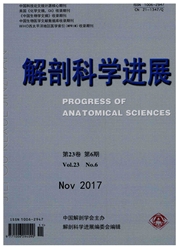

 中文摘要:
中文摘要:
目的研究锌对辣椒素致痛模型小鼠脊神经节P物质(substance P,SP)表达和热痛國的影响。方法 48只C57/BL6小鼠随机分4组,采用右后足底注射辣椒素(0.5%,5μ1)制备神经病理性疼痛(neuropathic pain,NPP)模型:对照组和适锌喂养组给予适锌饲料(锌30mg/kg/d);低锌喂养组给予低锌饲料(锌0.85mg/kg/d);高锌喂养组(H-NPP)给予硫酸锌水溶液(227mg/L/d)。2周后,对照组注射溶剂(吐温80、酒精和生理盐水混合液),其它三组注射辣椒素。应用金属自显影技术、热痛國检测、免疫组织化学和图像分析技术检测注射后7d锌对脊神经节SP表达和热痛國的影响。结果高锌喂养显著提高了脊神经节中锌的含量,降低SP的表达,使热痛國增高,痛敏减弱(P〈0.01);而低锌喂养能使脊神经节的锌更少,SP的表达更高,热痛國更低,痛敏更强(P〈0.01)。结论锌能抑制辣椒素致痛模型小鼠脊神经节SP的表达,使热痛國升高,痛敏降低。
 英文摘要:
英文摘要:
Objective To study the effect of zinc on the expression of substance P (SP) in dorsal root ganglian and the thermal pain threshold of capsaicin-induced neuropathic pain(NPP) in mice. Methods 48 C57/BL6 mice were divided into 4 groups randomly, then capsaicin was injected in the right hind foot of mice to build the NPP mice model. Mice in control group and N-NPP group were fed by normal food, in L-NPP group fed by low-zinc food, in H-NPP group fed by high-zinc food. Then the control group were injected with solvent (Tween 80, alcohol and saline), while the other group were injected with capsaicin 2 weeks later. Autometallography, thermal pain threshold observation, immunohistochemistry and image analysis were used to examine the effect of zinc on the expression of SP in dorsal root ganglian and the thermal pain threshold at the 7th day after injection. Results High-zinc feed can increase zinc level in dorsal root ganglian and the thermal pain threshold, downregulate the SP expression level(P〈 0.01). Low-zinc feed can reduce the zinc level in dorsal root ganglian and the thermal pain threshold, upregulate the SP expression level(P〈 0.01). Conclusion Zinc can inhibit the SP expression in dorsal root ganglion and improve the thermal pain threshold in capsaicin-induced NPP model mice.
 同期刊论文项目
同期刊论文项目
 同项目期刊论文
同项目期刊论文
 期刊信息
期刊信息
